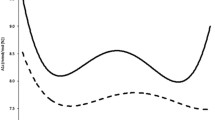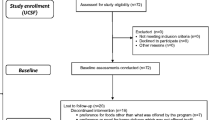Abstract
OBJECTIVES: Preliminary studies have shown that among adults with diabetes, food insufficiency has adverse health consequences, including hypoglycemic episodes and increased need for health care services. The purpose of this study was to determine the prevalence of food insufficiency and to describe the association of food insufficiency with health status and health care utilization in a national sample of adults with diabetes.
METHODS: We analyzed data from adults with diabetes (n=1,503) interviewed in the Third National Health and Nutrition Examination Survey. Bivariate and multivariate analyses were used to examine the relationship of food insufficiency to self-reported health status and health care utilization.
RESULTS: Six percent of adults with diabetes reported food insufficiency, representing more than 568,600 persons nationally (95% confidence interval, 368,400 to 768,800). Food insufficiency was more common among those with incomes below the federal poverty level (17% vs 4%, P≤.001). Adults with diabetes who were food insufficient were more likely to report fair or poor health status than those who were not (63% vs 43%; odds ratio, 2.2; P=.05). In a multivariate analysis, fair or poor health status was independently associated with poverty, nonwhite race, low educational achievement, and number of chronic diseases, but not with food insufficiency. Diabetic adults who were food insufficient reported more physician encounters, either in clinic or by phone, than those who were food secure (12 vs 7, P<.05). In a multivariate linear regression, food insufficiency remained independently associated with increased physician utilization among adults with diabetes. There was no association between food insufficiency and hospitalization in bivariate analysis.
CONCLUSIONS: Food insufficiency is relatively common among low-income adults with diabetes and was associated with higher physician utilization.
Similar content being viewed by others
References
Income, Poverty, and Valuation of Non-Cash Benefits: 1994. Washington, DC: US Dept of Commerce, Bureau of the Census; 1996. Series P-60. No. 189.
Carlson SJ, Andrews MS, Bickel GW. Measuring food insecurity and hunger in the United States: development of a national benchmark measure and prevalence estimates. J Nutr. 1999;129(28 suppl):510S-6S.
Radimer KL, Olsonm CM, Campbell CC. Development of indicators to assess hunger. J Nutr. 1990;120(suppl 11):1544–8.
Radimer KL, Olson CM, Greene JC, Campbell CC, Habicht J. Understanding hunger and developing indicators to assess it in women and children. J Nutr Educ. 1992;24:36S-44S.
Rose D. Economic determinants and dietary consequences of food insecurity in the United States. J Nutr. 1999;129(28 suppl):517S-20S.
Kuczmarski MF, Moshfegh A, Briefel R. Update on nutrition monitoring activities in the United States. J Am Diet Assoc. 1994;94:753–60.
Hamilton WL, Cook JT, Thompson WW, et al. Household Food Security in the United States in 1995. Summary Report. Alexandria, Va: USDA, Food and Consumer Service, Office of Analysis and Education; 1997.
Alaimo K, Briefel RR, Frongillo EA, Olson CM. Food insufficiency exists in the United States: results from the Third National Health and Nutrition Examination Survey (NHANES III). Am J Public Health. 1998;88:419–26.
Kok A. Food Security Survey of At-Risk Households, Green Bay, WI 1998. Green Bay, Wis: University of Wisconsin-Green Bay; 1999.
Nelson K, Brown M, Lurie N. Hunger in an adult patient population. JAMA. 1998;279:1211–4.
Kasper J, Gupta SK, Tran P, Cook JT, Meyers AF. Hunger in legal immigrants in California, Texas, and Illinois. Am J Public Health. 2000;90:1629–33.
Chandra RK. Effect of vitamin and trace element supplementation on immune responses and infection in elderly subjects. Lancet. 1992;340:1124–7.
Martin TR. The relationship between malnutrition and lung infections. Clin Chest Med. 1987;8:359–72.
Steffee WP. Malnutrition in hospitalized patients. JAMA. 1980;244:2630–5.
Roubenoff R, Roubenoff RA, Preto J, Balke CW. Malnutrition among hospitalized patients: a problem of physician awareness. Arch Intern Med. 1987;147:1462–5.
Robinson F, Goldstein M, Levine G. Impact of nutritional status on DRG length of stay. J Parental Enteral Nutr. 1987;11(1):49–51.
Hermann FR, Safran C, Levkoff SE, Minaker KL. Serum albumin level on admission as a predictor of death, length of stay, and readmission. Arch Intern Med. 1992;152:125–30.
Covinsky KE, Martin GE, Beyth RJ, Justice AC, Sehgal AR, Landefeld CA. The relationship between clinical assessments of nutritional status and adverse outcomes in older hospitalized medical patients. J Am Geriatr Soc. 1999;47:532–8.
Bidlack WR. Interrelationship of food, nutrition, diet and health: the National Association of State Universities and Land Grant Colleges White Paper. J Am Coll Nutr. 1996;15:422–33.
Murphy JM, Wehler CA, Pagano ME, Little M, Kleinman RE, Jellinek MS. Relationship between hunger and psychosocial functioning in low-income American children. J Am Acad Child Adolesc Psychiatry. 1998;37:163–70.
Frank DA, Ross N, Meyers A, et al. Seasonal variation in weight-for-age in a pediatric emergency room. Public Health Rep. 1996;111:366–71.
Alaimo K, Olson CM, Frongillo EA. Food insufficiency and children’s health status in the U.S.: findings from NHANES III. Manuscript submitted.
Kersey MA, Beran MS, McGovern PG, Biros M, Lurie N. The prevalence and effects of hunger in an emergency department patient population. Acad Emerg Med. 1999;6:1109–14.
Second Harvest. Hunger 1997: The Faces and Facts. Available at: www.secondharvest.org/research/faces/section11.html. Accessed August, 1998.
American Diabetic Association. Position Statement: Nutrition Recommendations and Principles for People with Diabetes Mellitus. Diabetes Care. 1996;21(suppl 1):S16–9.
Wolfe WS, Olson CM, Kendall A, Frongillo EA. Hunger and food insecurity in the elderly. J Aging Health. 1998;10:327–50.
National Center for Health Statistics. Plan and Operation of the Third National Health and Nutrition Examination Survey, 1988–1994. Hyattsville, Md: National Center for Health Statistics; 1994 Vital and Health Statistics Series. 1, No. 32.
National Center for Health Statistics. Third National Health and Nutrition Examination Survey, 1988–1994, Reference Manuals and Reports: Manual for Medical Technicians and Laboratory Procedures Used for NHANES III [book on CD-ROM]. Hyattsville, Md: Centers for Disease Control and Prevention: 1996.
National Health and Nutrition. Examination Survey III-Weighting and Estimation Methodology. Rockville Md: Westat, Inc; 1996.
Plan and Operation of the Third National Health and Nutrition Survey, 1988–1994. Vital Health Statistics [1]. Hyattsville, Md: U.S. Dept of Health and Human Services; 1994. DHHS publication PHS 94-1308.
Harris MI, Flegal KM, Cowie CC, et al. Prevalence of diabetes, impaired fasting glucose, and impaired glucose tolerance in U.S. adults: the Third National Health and Nutrition Examination Survey, 1988–1994. Diabetes Care. 1998;21:518–24.
Bush TL, Miller SR, Golden AL, Hale WE. Self-report and medical record report agreement of selected medical conditions in the elderly. Am J Public Health. 1989;79:1554–6.
Kehoe R, Wu SY, Leske MC, Chylack LT. Comparing self-reported and physician-reported medical history. Am J Epidemiol. 1994;139:813–8.
Heliovaara M, Aromaa A, Klaukka T, Kneckt P, Joukamaa M, Impivaara O. Reliability and validity of interview data on chronic diseases, The Min-Filand Health Survey. J Clin Epidemiol. 1993;46:181–91.
Midthjell K, Holmen J, Bjorndal A, Lund-Larsen G. Is questionnaire information valid in the study of a chronic disease such as diabetes? The Nord-Trondelag diabetes study. J Epidemiol Community Health. 1992;46:537–42.
Idler EL, Benyamini Y. Self-rated health and mortality: a review of twenty-seven community studies. J Health Soc Behav. 1997;38:21–37.
Dasbach EJ, Klein R, Klein BE, Moss SE. Self-rated health and mortality in people with diabetes. Am J Public Health. 1994;84:1775–9.
Farmer MM, Ferraro KF. Distress and perceived health: mechanisms of health decline. J Health Soc Behav. 1997;38:298–311.
Keller SD, Ware JE, Gandek B, et al. Testing the equivalence of translations of widely used response choice labels: Results from the IQOLA Project. International Quality of Life Assessment. J Clin Epidemiol. 1998;51:944–93.
Tarasuk N, Beaton GH. Women’s dietary intakes in the context of household food insecurity. J Nutr. 1999;129:672–9.
Briefel RR, Woteki CE. Development of food insufficiency questions for the Third National Health and Nutrition Examination Survey. J Nutr Educ. 1992;24:24S-8S.
Rose D, Oliveira V. Nutrient intakes of individuals from food-insufficient households in the United States. Am J Public Health. 1997;87:1956–61.
Rose D, Oliveira V. Validation of a Self-Reported Measure of Household Food Insecurity with Nutrient Intake Data. U.S. Dept of Agriculture Technical Bulletin. Washington, DC: U.S. Dept of Agriculture; 1997. No. 1863.
Christofar SP, Basiotis PP. Dietary intakes and selected characteristics of women ages 19–50 years and their children ages 1–5 years by reported perception of food sufficiency. J Nutr Educ. 1992;24:53–8.
Alaimo K. Food Insecurity, Hunger, and Food Insufficiency in the United States: Cognitive Testing of Questionnaire Items and Prevalence Estimates from the Third National Health and Nutrition Examination Survey [thesis]. Ithaca, NY: Cornell University; 1997.
Alaimo K, Olson CM, Frongillo EA. Importance of cognitive testing for survey items: an example from food security questionnaires. J Nutr Educ. 1999;31:269–75.
Update: prevalence of overweight among children, adolescents, and adults-United States, 1988–1994. MMWR Morb Mortal Wkly Rep. 1997;46:199–202.
Kawachi I, Kennedy BP, Glass R. Social capital and self-rated health: a contextual analysis. Am J Public Health. 1999;98:1187–93.
Farmer MM, Ferraro KF. Distress and perceived health: mechanisms of health decline. J Health Soc Behav. 1997;38:298–311.
Goroll AH, May LA, Mulley AG, eds. Primary Care Medicine. Philadelphia, Pa: Lippincott; 1995:562.
American Diabetes Association. Clinical practice recommendations 1999. Diabetes Care. 1999;22(suppl 1):S1–114.
Korn EL, Graubard BI. Epidemiologic studies utilizing surveys: accounting for the sampling design. Am J Public Health. 1991;81:1166–73.
Sundquist J. Ethnicity, social class and health. Soc Sci Med. 1995;40:777–87.
Hemingway H, Nicholson A, Stafford M, Roberts R, Marmot M. The impact of socioeconomic status on health functioning as assessed by the SF-36 questionnaire: the Whitehall II study. Am J Public Health. 1997;87:1484–90.
Kennedy BP, Kawachi I, Glass R, Prothrow-Stith D. Income distribution, socioeconomic status, and self-rated health in the United States: multilevel analysis. BMJ. 1998;317:917–21.
Gelberg L, Gallagher TC, Andersen R, Koegel P. Competing priorities as a barrier to medical care among homeless adults in Los Angeles. Am J Public Health. 1997;87:217–20.
Wiecha JL, Dwyer JT, Dunn-Strohecker M. Nutrition and health services needs among the homeless. Public Health Rep. 1991;106:364–74.
Cowie CC, Harris MI. Ambulatory medical care for non-Hispanic whites, African-Americans, and Mexican Americans with NIDDM in the U.S. Diabetes Care. 1997;20:142–7.
Ruggiero L, Glasgow RE, Dryfoos JM, et al. Diabetes self-management: self-reported recommendations and patterns in a large population. Diabetes Care. 1997;20:568–76.
Hunt LM, Pugh J, Valenzuela M. How patients adapt diabetes self-care recommendations in everyday life. J Fam Pract. 1998;46:207–15.
American Diabetes Association. Standard of medical care of patients with diabetes mellitus. Diabetes Care. 1999;22(suppl 1):1–19.
American Diabetes Association. Economic consequences of diabetes mellitus in the U.S. in 1997. Diabetes Care. 1998;21(2):296–309.
Jones JY, Richardson J. Federal Food Programs: Legislation in the 104th Congress: Congressional Research Service Report for Congress. Washington, DC: Congressional Research Service; October 29; 1996. Document 96-861 ENR.
Food Research and Action Center. State Government Responses to the Food Assistance Gap 1998. Washington, DC: Food Research and Action Center; 1998.
Food Research and Action Center. Summary of Nutrition Provisions in the Welfare Reform Conference Report. Washington, DC: Food Research and Action Center; 1996.
Burt MR. Hunger Among the Elderly: Local and National Comparisons. Washington, DC: The Urban Institute; 1993.
Rose D, Gundersen C, Oliveira V. Socio-Economic Determinants of Food Insecurity in the United States: Evidence from the SIPP and CSFII Datasets. Technical Bulletin 1869. Washington, DC: Economic Research Service, U.S. Dept of Agriculture; 1998.
Edwards DL, Frongillo EA, Rauschenbach BR, Roe DA. Home-delivered meals benefit the diabetic elderly. J Am Diet Assoc. 1993;93:585–7.
Author information
Authors and Affiliations
Corresponding author
Additional information
Karin Nelson was a NRSA research fellow in the Division of General Medicine at UCLA when this study was conducted. Lillian Gelberg is a Robert Wood Johnson Foundation Generalist Physician Faculty Scholar. William Cunningham is a Doris Duke Charitable Foundation Clinical Scientist.
Rights and permissions
About this article
Cite this article
Nelson, K., Cunningham, W., Andersen, R. et al. Is food insufficiency associated with health status and health care utilization among adults with diabetes?. J GEN INTERN MED 16, 404–411 (2001). https://doi.org/10.1046/j.1525-1497.2001.016006404.x
Issue Date:
DOI: https://doi.org/10.1046/j.1525-1497.2001.016006404.x




